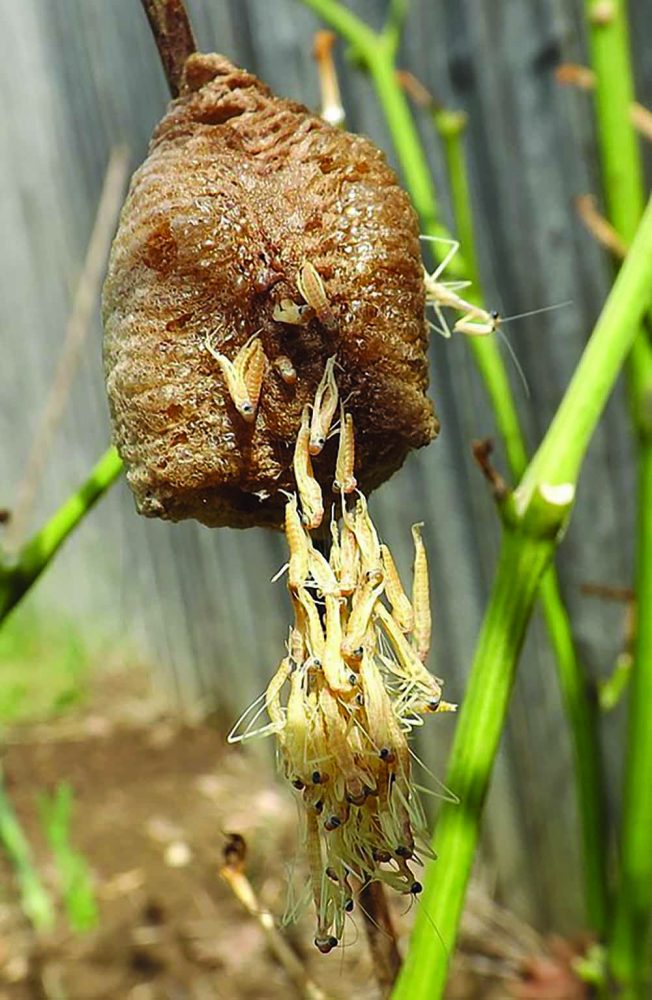
I know a lot of people don’t like to talk about bugs and insects. But the praying mantis is one of those more iconic insects that´s loved by many and stands out in our gardens. It´s size, beautiful colors, and graceful form and movements almost commands us to look and ponder. Which is probably the reason for all the folklore about the praying mantis. As a little girl, I was fascinated with praying mantis and still am. If I was fortunate enough to see one, I would pick it up and place it on my shoulder and walk around enjoying my new pet. My father would tell me to be careful with it because it was a federally protected insect and to be sure to put it back where I found it. And as always, I would do so. Since that time, I have learned that the mantis is not a protected insect by either state or federal law.
Spotting a praying mantis is not an easy thing to do. That’s because they are masters of camouflage. This allows them to blend in with sticks and leaves around them and wait, sometimes for hours, for their food to come to them. These carnivores have a ferocious appetite for other insects and bugs. They have learned to wait for the perfect moment to strike. They are patient and precise when on the hunt for food and will only attach when they are 100% sure of success. Adults are often very territorial and can claim a fairly large area as its exclusive hunting grounds. And if another mantis enters that territory, it soon will be the next meal!
The praying mantis has been around for a while since the Cretaceous Period…166 million years ago. They are found on every continent except Antarctica. And in the United States we find them in our gardens, forest and even the desert. It gets its name from its prominent front legs, which are bent and held together below the head that suggests the position of prayer. Most of us are able to identify the praying mantis, but did you know there are many species both native and invasive in our area? The three most widespread species in North America are the Chinese, European and Carolina Mantis. The Chinese and European are the two most invasive mantises that pose a threat to our smaller, native Carolina Mantis. The Chinese mantis is the largest and most commonly seen species and can reach up to five inches in length and was introduced to our country in 1896. The European mantis was accidentally introduced into the eastern US in 1899 on plants intended for a nursery. More mantises were brought in later as pest control for the gypsy moth caterpillar. It is smaller than the Chinese mantis but still reaches a length of about four inches. And both can be found across the United States. The native Carolina Mantis, South Carolina state insect, is up to three inches in length and because of its size is often eaten by the larger ones.

The praying mantis is probably the only insect able to swivel its triangular head 180 degrees and stare straight at you. They have five eyes of which two are compound and three are simple giving them the ability to see things in a three-dimensional way like humans do and can see movements up to sixty feet away. They have one ´ear´ located in the middle of their abdomen that allows them to hear only ultrasonic sounds. This is beneficial to them since bats are their number one predator. The adult life span of the Carolina mantis is 4 to 8 weeks while the larger live 4-6 months. Their coloration varies from brown to green and the female is bigger than the male. Both have wings that develop in adulthood, but it is usually only the male that can fly…females are typically too heavy to lift off the ground.
The female mantis may kill and eat the male either during or sometimes after mating. Once they mate, she produces up to 400 eggs over a period of several days in a hard frothy liquid. The entire egg sack feels like Styrofoam and is known as ootheca.
Praying mantises have a history of being regarded as mystical creatures. Ancient Greek saw them as prophets. While Ancient China describes them as the symbol of courage and intrepidness. In fact, the praying mantis´ movements have actually inspired at least two known styles of ancient Chinese martial arts. In Japan, the mantis is sometimes regarded as a death omen. And one of my friends even believes that its saliva can blind you…not true! I prefer the more positive superstition that it is a symbol of spirituality and that the angels are watching over you.
Most of us hold the praying mantis in high regards…a beneficial insect that is considered a friend to farmers and gardeners. Their cool, calm demeanor along with a ferocious appetite for insects works well as a natural form of pest control. And, yes, once in a while they eat a good bug, too. But their preference is for the insects that do the greatest damage to crops and flowers…grasshoppers, beetles, and other small insects. ■


